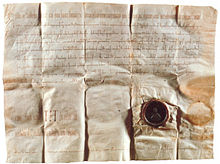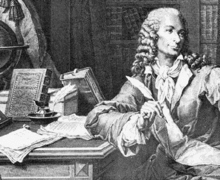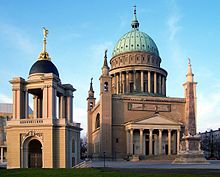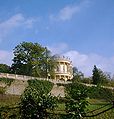This is an old revision of this page, as edited by John (talk | contribs) at 21:08, 4 September 2012 (→Twin towns — sister cities: deflag). The present address (URL) is a permanent link to this revision, which may differ significantly from the current revision.
Revision as of 21:08, 4 September 2012 by John (talk | contribs) (→Twin towns — sister cities: deflag)(diff) ← Previous revision | Latest revision (diff) | Newer revision → (diff) For other uses, see Potsdam (disambiguation). City in Brandenburg, Germany| Potsdam | |
|---|---|
| City | |
 View over Potsdam View over Potsdam | |
 Coat of arms Coat of arms | |
| Location of Potsdam | |
| Country | Germany |
| State | Brandenburg |
| District | Urban district |
| Government | |
| • Lord mayor | Jann Jakobs (SPD) |
| Area | |
| • Total | 187.28 km (72.31 sq mi) |
| Highest elevation | 114 m (374 ft) |
| Lowest elevation | 35 m (115 ft) |
| Population | |
| • Total | 185,750 |
| • Density | 990/km (2,600/sq mi) |
| Time zone | UTC+01:00 (CET) |
| • Summer (DST) | UTC+02:00 (CEST) |
| Postal codes | 14401–14482 |
| Dialling codes | 0331 |
| Vehicle registration | P |
| Website | www.potsdam.de |
Potsdam (Template:IPA-de) is the capital city of the German federal state of Brandenburg and part of the Berlin/Brandenburg Metropolitan Region. It is situated on the River Havel, 24 kilometres (15 miles) southwest of Berlin city centre.
The name "Potsdam" originally seems to have been "Poztupimi" from a West Slavonic name meaning "beneath the oaks", highlighting the area's many grand oak trees.
Potsdam has several claims to national and international notability. In Germany, it had the status Windsor has in Britain: it was the residence of the Prussian kings and German Kaisers, until 1918. Around the city there are a series of interconnected lakes and unique cultural landmarks, in particular the parks and palaces of Sanssouci, the largest World Heritage Site in Germany. The Potsdam Conference, the major post-World War II conference between the victorious Allies, was held at another palace in the area, the Cecilienhof.
Babelsberg, in the south-eastern part of Potsdam, was a major film production studio before the war and has enjoyed increased success as a major centre of European film production since the fall of the Berlin Wall. The Filmstudio Babelsberg is the oldest large-scale film studio in the world.
Potsdam developed into a centre of science in Germany from the 19th century. Today, there are three public colleges and more than 30 research institutes in the city.
Geography


The area was formed from a series of large moraines left after the last ice age. Today, the city is three-quarters green space, with just a quarter as urban area. There are about 20 lakes and rivers in and around Potsdam, such as the Havel, the Griebnitzsee, Templiner See, Tiefer See, Jungfernsee, Teltowkanal, Heiliger See and the Sacrower See. The highest point is the 114-metre (374 ft) high Kleiner Ravensberg.
Potsdam is divided into seven historic city districts and nine new Ortsteile (villages), which joined the city in 2003. The appearances of the city districts are quite different. The districts in the north and in the centre consist mainly of historical buildings, the south of the city is dominated by larger areas of newer buildings.
History



The area around Potsdam shows occupancy since the Bronze Age and was part of Magna Germania as described by Tacitus. After the migrations, Slavs moved in and Potsdam was probably founded after the 7th century as a settlement of the Heveller centred on a castle. It was first mentioned in a document in 993AD as Poztupimi, when Emperor Otto III gifted the territory to the Quedlinburg Abbey, then led by his aunt Matilda. A possible translation of the name might be beneath the oaks. By 1317, it was mentioned as a small town. It gained its town charter in 1345. In 1573, it was still a small market town of 2,000 inhabitants. Potsdam lost nearly half of its population due to the Thirty Years' War (1618–1648).
A continuous Hohenzollern possession since 1415, Potsdam became prominent, when it was chosen in 1660 as the hunting residence of Frederick William I, Elector of Brandenburg, the core of the powerful state that later became the Kingdom of Prussia. It also housed Prussian barracks.

After the Edict of Potsdam in 1685, Potsdam became a centre of European immigration. Its religious freedom attracted people from France (Huguenots), Russia, the Netherlands and Bohemia. The edict accelerated population growth and economic recovery.
Later, the city became a full residence of the Prussian royal family. The majestic buildings of the royal residences were built mainly during the reign of Frederick the Great. One of these is the Sanssouci Palace (French: "without cares", by Georg Wenzeslaus von Knobelsdorff, 1744), famed for its formal gardens and Rococo interiors. Other royal residences include the New Palace and the Orangery.
In 1815, at the formation of the Province of Brandenburg, Potsdam became the provincial capital until 1918, however, interrupted and succeeded by Berlin as provincial capital between 1827 and 1843, and after 1918. The province comprised two governorates named after their capitals Potsdam and Frankfurt (Oder).
Governorate of Potsdam
Between 1815 and 1945 the city of Potsdam served as capital of the governorate of Potsdam (Template:Lang-de). The Regierungsbezirk encompassed the former districts of Uckermark, the Mark of Priegnitz, and the greater part of the Middle March. It was situated between Mecklenburg and the Province of Pomerania on the north, and the Province of Saxony on the south and west (Berlin, with a small surrounding district, was an urban governorate and enclave within the governorate of Potsdam between 1815 and 1822, then it merged as urban district into the governorate only to be disentangled again from Potsdam governorate in 1875, becoming an own distinct province-like entity on 1 April 1881). Towards the north west the governorate was bounded by the rivers Elbe and the Havel, and on the north east by the Oder. The southeastern boundary was to the neighbouring governorate of Frankfurt (Oder). About 500,000 inhabitants lived in the Potsdam governorate, which covered an area of about 20,700 square kilometres, divided into thirteen rural districts, named after their capitals:
| Angermünde | Beeskow-Storkow (as of 1836) | East Havelland | East Prignitz |
| Jüterbog-Luckenwalde | Lower Barnim | Prenzlau | Ruppin |
| Teltow (as of 1836) | Teltow-Storkow (until 1835) | Templin | Upper Barnim |
| West Havelland | West Prignitz | Zauch-Belzig |
The traditional towns in the governorate were small, however, in the course of the industrial labour migration some reached the rank as urban districts. The principal towns were Brandenburg upon Havel, Köpenick, Potsdam, Prenzlau, Spandau and Ruppin. Until 1875 also Berlin was a town within the governorate. After its disentanglement a number of its suburbs outside Berlin's municipal borders grew to cities, many forming urban within the governorate of Potsdam such as Charlottenburg, Lichtenberg, Rixdorf (after 1912 Neukölln), and Schöneberg (all of which, as well as Köpenick and Spandau, incorporated into Greater Berlin in 1920). The urban districts were (years indicating the elevation to rank of urban district or affiliation with Potsdam governorate, respectively):
| Berlin (1822–1875) | Brandenburg/Havel (as of 1881) | Charlottenburg (1877–1920) | Eberswalde (as of 1911) |
| Lichtenberg (1908–1920) | Schöneberg (1899–1920) | Deutsch-Wilmersdorf (1907–1920) | Rixdorf (Neukölln) (1899–1920) |
| Potsdam | Rathenow (as of 1925) | Spandau (1886–1920) | Wittenberge (as of 1922) |
Potsdam in the 20th century
Berlin was the official capital of Prussia and later of the German Empire, but the court remained in Potsdam, where many government officials settled. In 1914, the Emperor Wilhelm II signed the Declaration of War in the Neues Palais. The city lost its status as a second capital in 1918, when Wilhelm II abdicated at the end of World War I.
At the start of the Third Reich in 1933 there was a ceremonial handshake between President Paul von Hindenburg and the new Chancellor Adolf Hitler on 21 March 1933 in Potsdam's Garrison Church in what became known as the "Day of Potsdam". This symbolised a coalition of the military (Reichswehr) and Nazism. Potsdam was severely damaged in bombing raids during World War II.

The Cecilienhof Palace was the scene of the Potsdam Conference from 17 July, to 2 August 1945, at which the victorious Allied leaders (Harry S. Truman; Winston Churchill and his successor, Clement Attlee; and Joseph Stalin) met to decide the future of Germany and postwar Europe in general. The conference ended with the Potsdam Agreement and the Potsdam Declaration.

The government of East Germany (formally known as the German Democratic Republic (German: Deutsche Demokratische Republik, DDR)) tried to remove symbols of Prussian militarism. Many historic buildings, some of them badly damaged in the war, were demolished.
When in 1946 the remainder of the Province of Brandenburg west of the Oder-Neiße line was constituted as the state of Brandenburg, Potsdam became its capital. In 1952 the GDR disestablished its federative states and replaced them by smaller new East German administrative districts. Potsdam became the capital of the new Bezirk Potsdam until 1990.
Potsdam, south-west of Berlin, lay just outside West Berlin after the construction of the Berlin Wall. The walling off of West Berlin not only isolated Potsdam from West Berlin, but also doubled commuting times to East Berlin. The Glienicke Bridge across the Havel connected the city to West Berlin and was the scene of some Cold War exchanges of spies.
After German reunification, Potsdam became the capital of the newly re-established state of Brandenburg. There are many ideas and efforts to reconstruct the original appearance of the city, most remarkably the Potsdam City Palace and the Garrison Church.
Politics
Administration

Potsdam has had a mayor (Bürgermeister) and city council since the 15th century. From 1809 the city council was elected, with a mayor (Oberbürgermeister) at its head. During the Third Reich the mayor was selected by the NSDAP and the city council was dissolved; it was reconstituted in token form after the Second World War, but free elections did not take place until after reunification.
Today, the city council is the city's central administrative authority. Local elections took place on 26 October 2003 and again in 2008. Between 1990 and 1999, the Chairman of the City Council was known as the "Town President" but today the post is the "Chairman of the City Council". The mayor is elected directly by the population. In the mayoral election on 22 September 2002, no candidate gained an overall majority, and a run-off election was held between Jann Jakobs (SPD) and Hans-Jürgen Scharfenberg (PDS), with Jann Jakobs gaining the narrowest of victories, with 50.1%.
The Landtag Brandenburg, the parliament of the federal state of Brandenburg is in Potsdam. It is planned to move into the Potsdam City Palace in 2011, after its reconstruction.
International relations
Main article: List of twin towns and sister cities in GermanyTwin towns — sister cities
Potsdam is twinned with the following cities:
| Opole | Poland | 1973 | Perugia | Italy | 1990 | ||
| Bobigny | France | 1974 | Sioux Falls | South Dakota, USA | 1990 | ||
| Jyväskylä | Finland | 1985 | Bonn | North Rhine-Westphalia | 1988 | ||
| Lucerne | Switzerland | 2002 |
Education and research

Potsdam is a university town. The University of Potsdam was founded in 1991 as a university of the State of Brandenburg. Its predecessor was the Akademie für Staats- und Rechtswissenschaften der DDR "Walter Ulbricht", a college of education founded in 1948 which was one of the GDR's most important colleges. There are about 20,000 students enrolled at the university.

In 1991 the Fachhochschule was founded as the second college; it now has 2,400 students.
In addition there is a College of Film and Television (Hochschule für Film und Fernsehen "Konrad Wolf" HFF), founded in 1954 in Babelsberg, the foremost centre of the German film industry since its birth, with currently 600 students.
There are also several research foundations, including Fraunhofer Institutes for Applied Polymer Research and Biomedical Engineering, Max Planck Institutes for Gravitational Physics (Albert Einstein Institute), Colloids and Interfaces, and Molecular Plant Physiology, the GFZ German Research Centre for Geosciences, the Potsdam Astrophysical Institute and the Potsdam Institute for Climate Impact Research, which employs 140 people in researching climate change.
As well as universities, Potsdam is home to reputable secondary schools. Montessori Gesamtschule Potsdam, in western Potsdam, attracts 400 students from the Brandenburg and Berlin region.
Main sights
Main article: List of sights of Potsdam
Potsdam was historically a centre of European immigration. Its religious tolerance attracted people from France, Russia, the Netherlands and Bohemia. This is still visible in the culture and architecture of the city.
The most popular attraction in Potsdam is Sanssouci Park, 2 km west of the city centre. In 1744 King Frederick the Great ordered the construction of a residence here, where he could live sans souci ("without worries", in the French spoken at the court). The park hosts a botanical garden (Botanical Garden, Potsdam) and many magnificent buildings:
- The Sanssouci Palace (Schloss Sanssouci), a relatively modest palace of the Prussian royal and German imperial family
- The Orangery Palace (Orangerieschloss), former palace for foreign royal guests
- The New Palace (Neues Palais), built between 1763 and 1769 to celebrate the end of the Seven Years' War, in which Prussia ousted Austria from its centuries-long role as the dominant power in German affairs. It is a much larger and grander palace than Sanssouci, having over 200 rooms and 400 statues as decoration. It served as a guest house for numerous royal visitors. It is now housing parts of University of Potsdam.
- The Charlottenhof Palace (Schloss Charlottenhof), a Neoclassical palace by Karl Friedrich Schinkel built in 1826
- The Roman Baths (Römische Bäder), built by Karl Friedrich Schinkel and Ludwig Persius in 1829-1840. It is a complex of buildings including a tea pavilion, a Renaissance-style villa, and a Roman bathhouse (from which the whole complex takes its name).
- The Chinese Tea House (Chinesisches Teehaus), an 18th century pavilion built in a Chinese style, the fashion of the time.
Three gates from the original city wall remain today. The oldest is the Hunters' Gate (Jägertor), built in 1733. The Nauener Tor was built in 1755 and close to the historic Dutch Quarter. The ornate Brandenburg Gate (built in 1770, not to be confused with the Brandenburg Gate in Berlin) is situated on the Luisenplatz at the western entrance to the old town.


The Old Market Square (Alter Markt) is Potsdam's historical city centre. For three centuries this was the site of the City Palace (Stadtschloß), a royal palace built in 1662. Under Frederick the Great, the palace became the winter residence of the Prussian kings. The palace was severely damaged by bombing in 1945 and demolished in 1961 by the Communist authorities. In 2002 the Fortuna Gate (Fortunaportal) was rebuilt in its original historic position, which marks the first step in the reconstruction of the palace.
The Old Market Square is dominated today by the dome of St. Nicholas' Church (Nikolaikirche), built in 1837 in the classical style. It was the last work of Karl Friedrich Schinkel, who designed the building but did not live to see its completion. It was finished by his disciples Friedrich August Stüler and Ludwig Persius. The eastern side of the Market Square is dominated by the Old City Hall (Altes Rathaus), built in 1755 by the Dutch architect Jan Bouman (1706–1776). It has a characteristic circular tower, crowned with a gilded Atlas bearing the world on his shoulders.


North of the Old Market Square is the oval French Church (Französische Kirche), erected in the 1750s by Boumann for the Huguenot community.
Another landmark of Potsdam is the two-street Dutch Quarter (Holländisches Viertel), an ensemble of buildings that is unique in Europe, with about 150 houses built of red bricks in the Dutch style. It was built between 1734 and 1742 under the direction of Jan Bouman to be used by Dutch artisans and craftsmen who had been invited to settle here by King Frederick Wilhelm I. Today, this area is one of Potsdam's most visited districts.
North of the city centre is the Russian colony of Alexandrowka, a small enclave of Russian architecture (including an Orthodox chapel) built in 1825 for a group of Russian immigrants. Since 1999, the colony has been a UNESCO World Heritage Site.
East of the Alexandrowka colony is a large park, the New Garden (Neuer Garten), which was laid out from 1786 in the English style. The site contains two palaces; one of them, the Cecilienhof, was where the Potsdam Conference was held in July and August 1945. The Marmorpalais (Marble Palace) was built in 1789 in the style of classicism. Nearby is the Biosphäre Potsdam, a tropical botanical garden.
Another interesting district of Potsdam is Babelsberg, a quarter south-east of the centre, housing the UFA film studios (Babelsberg Studios), and an extensive park with some historical buildings, including the Babelsberg Palace (Schloß Babelsberg, a neo-Gothic palace designed by Schinkel).
The Albert Einstein Science Park is the sight of the Einstein Tower, which is on the top of the Telegraphenberg within an astronomy compound.
There are many parks in Potsdam, most of them included in UNESCO World Heritage Sites. Some of them are:
- Parks in Potsdam
-
 The Belvedere near Sanssouci Park
The Belvedere near Sanssouci Park
-
 View from Babelsberg Park to Berlin.
View from Babelsberg Park to Berlin.
-
 The Chinese House
The Chinese House
Potsdam also includes a memorial centre in the former KGB prison in Leistikowstraße.

Transport
- Rail transport: Potsdam, included in the fare zone "C" (Tarifbereich C) of Berlin's public transport area, is served by the S7 S-Bahn line. The stations served are Griebnitzsee, Babelsberg and the Central Station (Hauptbahnhof), the main and long-distance station of the city. Other DB stations in Potsdam are Charlottenhof, Park Sanssouci (including the monumental Kaiserbahnhof), Medienstadt Babelsberg (formerly Drewitz), Rehbrücke and Pirschheide. The city also possesses a 27 km-long tramway network.
- Road transport: Potsdam is served by several motorways: the A 10, a beltway better known as Berliner Ring, the A 115 (using part of the AVUS) and is closely linked to the A 2 and A 9. The B 1 and B 2 federal roads cross the city. Potsdam counts a network of urban and suburban buses and trolleybuses.
Sport
- 1. FFC Turbine Potsdam, one of the most successful German female football clubs (Bundesliga (women))
- SV Babelsberg 03, football club (3. Bundesliga)
- Olympic training centre Potsdam
- USV Potsdam, Rugby union (2nd Rugby-Bundesliga) and Football (Kreisklasse)
- List of football clubs in Potsdam
- The Potsdamer Schlössermarathon (Potsdam Palace Marathon) is a marathon in that is held annually in June. Thousands of runners run the course past the palaces for the half marathon and several hundred repeat the course to complete the full marathon.
Famous people
- Famous people from Potsdam who are the subjects of Misplaced Pages articles can be found here.
References
- "Bevölkerungsentwicklung und Bevölkerungsstandim Land Brandenburg Dezember 2022" (PDF). Amt für Statistik Berlin-Brandenburg (in German). June 2023.
- http://www.potsdam.de/cms/beitrag/10000936/33981/
- ^ Thomas Curtis (1839). The London encyclopaedia, or, Universal dictionary of science, art, literature, and practical mechanics, by the orig. ed. of the Encyclopaedia metropolitana Volume XVIII, p. 11
- "Die Partnerstädte der Landeshauptstadt Potsdam". www.potsdam.de (in German). Retrieved 24 June 2010.
- Template:De icon BVG: Berliner public transport pdf maps showing fare zones
Sources
- Paul Sigel, Silke Dähmlow, Frank Seehausen und Lucas Elmenhorst, Architekturführer Potsdam Architectural Guide, Dietrich Reimer Verlag, Berlin 2006, ISBN 3-496-01325-7.
External links
| Urban districts | |
|---|---|
| Rural districts | |
| Districts of German states (Full list) | |
| Capitals of states of the Federal Republic of Germany | |
|---|---|
| Capitals of area states |
|
| City-states | |
| Capitals of former states |
|
| |
| Cities in Germany by population | |
|---|---|
| 1,000,000+ | |
| 500,000–999,999 | |
| 200,000–499,999 | |
| 100,000–199,999 |
|
| Capitals of the East German Bezirke | ||
|---|---|---|
Template:Link FA Template:Link FA
Categories: